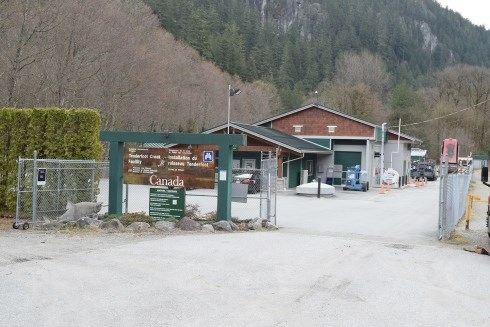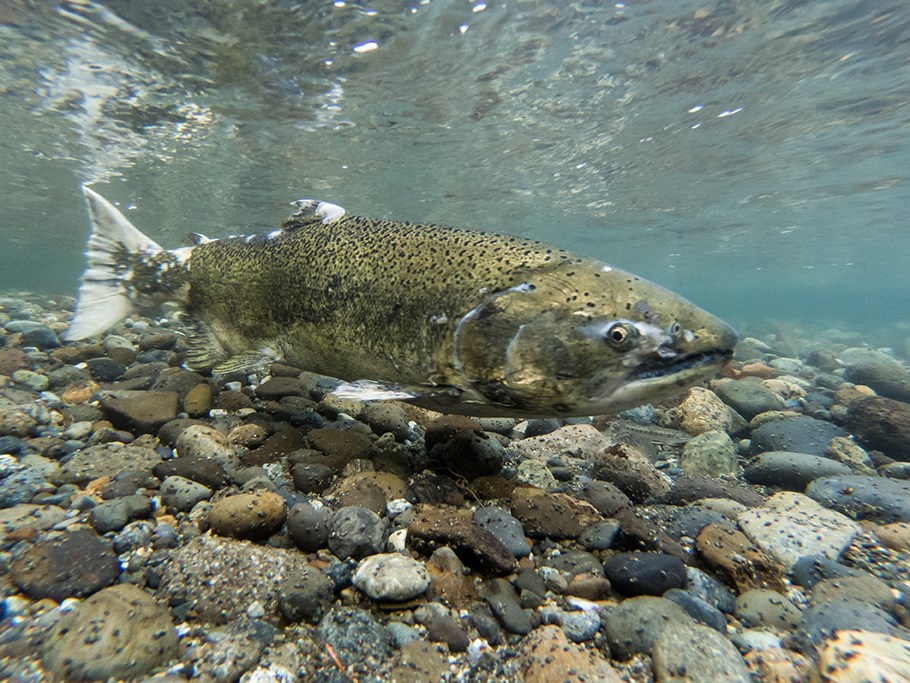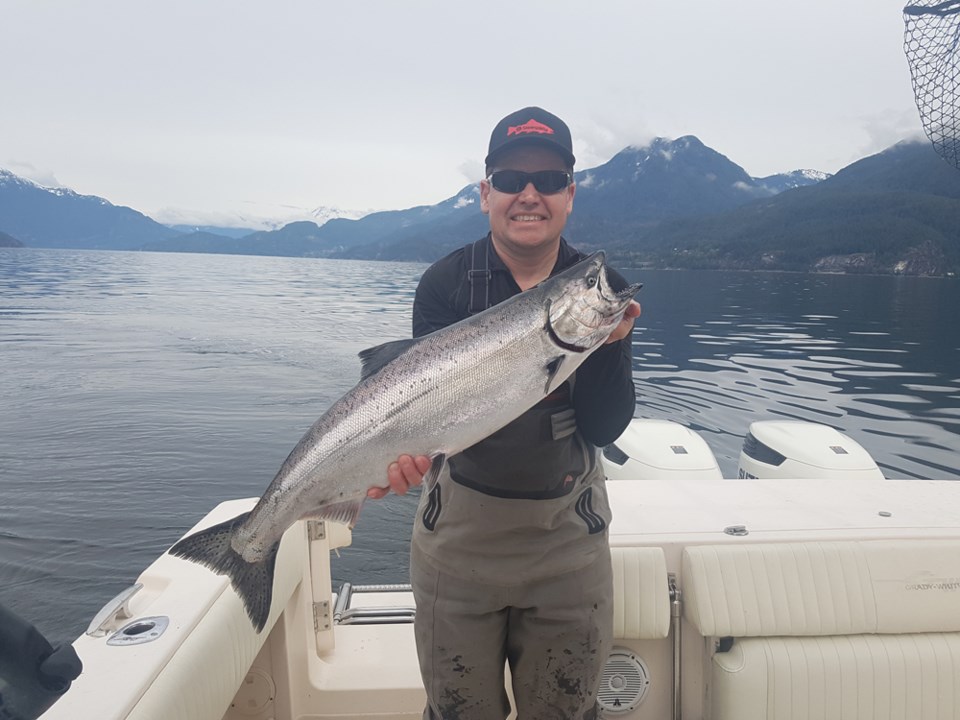Sea to Sky sports anglers say government regulations that restrict the harvesting of chinook salmon on the south coast, including in Howe Sound, are not based on science.
Among other things, they are calling for an opening of the fishery in local waters for the retention of one chinook salmon per outing.
In April 2019, fishers were banned from catching chinook in the south coast fishery. Those regulations have so far been rolled into this year.
Jason Assonitis, who has been a fishing guide in local waters for more than 30 years and angler Dave Brown, vice-chair of the Squamish to Lillooet Sport Fish Advisory Committee both want Fisheries and Oceans Canada (DFO) to immediately implement recommendations recently put forward by the Sport Fishery Advisory Board.
That board has been an advisory body to the Minister of Fisheries, Oceans and Canadian Coast Guard Canada (DFO) on public fishery issues since 1964.
Its recent recommendations are based on data from over 15 years of recreational anglers and also from coded wire tag collection through DFO programs, the men say.
In addition to calling for the retention of hatchery chinook, in the longer term, the advisory board proposal also calls for the mass marking of 100% of hatchery chinook.
Brown said if the DFO adopted the Board's proposals tomorrow, it would allow for "opportunities for all groups to have access to going out of having the enjoyment of being on the water, giving a kickstart to the economy and having an opportunity to get out and fish and retain a hatchery chinook salmon."
The board's formal proposal was submitted to the DFO and Bernadette Jordan, minister of fisheries, oceans and the Canadian Coast Guard.
It has yet to be acted on.
There is no time to waste, the anglers say.
Assonitis, who also owns Bon Chovy fishing charters, said last year's regulations meant a lot of uncertainty.
"We probably dropped 50% to 60%. It also instilled uncertainty in the recreational sector," he said.
The board report submitted calls this 2020 fishing season "transitional in the history of recreational chinook management around southern B.C.
"What we have seen is we have gone from the closure we had last year and we are into the same measures again this year. Closing down the majority of the south coast has a significant impact on all Canadians and British Columbians and all user groups and their ability to get out and enjoy fishing for salmon in a responsible conservation-minded manner, when there are also lots of healthy salmon stocks out there," said Brown.
Brown said last season he experienced the best chinook salmon fishing — using catch and release — he'd seen in years.
Assonitis has collected chinook salmon DNA in Howe Sound and the Southern Georgia Strait over the last eight years and the data that he collected was used to inform the Sport Fishery Advisory Board in the proposal.
Mass Marking
Mass marking refers to putting a tag on the adipose fin of hatchery chinook from Canadian hatcheries.
For the most part, only 10% are currently marked in Canada.
"Hatchery chinook, by and large, are meant for public consumption — First Nations, commercial and recreational — but during these periods where there are threatened chinook in the area, one of the ways to avoid these stocks of concern is by being able to retain hatchery fish," Assonitis said. "So local anglers and First Nations can try and avoid the stocks."
In local waters, depending on the time of year, Assonitis said 30 to 50% of the fish they encounter are tagged because a lot of the fish caught here are from Puget Sound. In Washington State, 100% of fish are marked, Assonitis said.

Hatchery perspective
Jordan Uittenbogaard, watershed manager at the Tenderfoot Creek Hatchery, who spoke to The Chief in his role at the hatchery, not on behalf of DFO management, said that he sees where the sports fishers are coming from but said that the fisheries were closed by the DFO last year to protect specific stocks of Fraser River chinook that have seen record low returns for years.
"My personal view, and DFO's mandate, is to provide recreation fisheries for people, but also to preserve and protect, so that was a hard decision for them," he said. "They didn't get any votes out of that.... To protect any species that is threatened is never a bad idea."
Assonitis said it would be relatively easy to avoid catching stocks of concern by avoiding known migration corridors.
"It is taking a step back. It is far removed from the migration corridors, where data is showing that the risk is virtually zero," he said.
"It is known that these early-time Fraser chinook that need to be protected — they take a pretty clear and consistent path from open sea. They don't reside in local waters year-round," he said, of the first migratory chinook to arrive at the beginning of April. "They transit local waters very quickly."
Therefore, the fish that recreational anglers target day-in-day-out are different from the ones that need protection, he added.
"Everybody realizes that early Fraser chinook salmon are not doing well. But we also realize that they take a very predictable path from open sea," Assonitis said.
"The recreational sector has been given a very slim margin of impact because priority access to these fish must go to First Nations first, by constitutional priority, and we understand that and so within that there is a slim margin for impact. That is why these areas have been looked at to get the impact on these fish down to zero."
If the DFO can't look at options like this that are going to have close to zero impact, Assonitis said, "Then, where do we go from here? If zero is not good enough?"
Uittenbogaard told The Chief the problem with the proposal for this year is that the hatchery fish mostly found in Howe Sound are from Tenderfoot and those stocks are rebuilding stocks. The hatchery chinook are currently marked for assessment purposes, he said.
"We produce hatchery fish for coho, which populations are doing good and we mark them and that is for the recreational fishery, whereas our chinook salmon in Squamish are not doing great and that is why the hatchery is here," he said.
The hatchery has been working since 2014 to rebuild the stocks, and it is happening, Uittenbogaard said.
"I do understand what they are saying and I think we are going to get there," he said.
It is very expensive to mark fish, he said, adding the equipment, labour and tags are all costly.
DFO just bought an automatic marking trailer, which is now on Vancouver Island, which makes marking more effient, he said.
This year, the plan pre-COVID was for a second trailer that does markings to be purchased for Lower Mainland hatcheries.
With those trailers, up to 60,000 coho or chinook can be marked per day. At Tenderfoot currently, they can mark about 10,000.
A plan, too, is underway to alter the Squamish Spit to allow for the better flow of juvenile fish through the area. The argument for this is that chinook numbers have been negatively impacted by the structure.
So how can the sports fishers say they want to fish for chinook in the same waters?
Brown told The Chief that the improved health of the sound over recent years has resulted in increased herring, anchovies and baitfish, which has led to chinook arriving from a variety of places.
"Howe Sound has really come back and is drawing in fish from a number of areas and fish that are now in the sound are not just Squamish River chinook stocks. There is a large component from Puget Sound, the Chilliwack hatchery, as well we are seeing an improvement in our Squamish chinook levels," he said, adding that the Tenderfoot Creek Hatchery programs, and the work of other local groups such as the Squamish River Watershed Society and Squamish Streamkeepers have improved the health of the ecosystem all around.
"If we were just relying on Squamish River chinook coming in, that would be a different story," he said.

Shadow Minister weighs in
Conservative Party of Canada MP Mel Arnold, the shadow minister for Fisheries, Oceans and the Canadian Coast Guard, also sat on the mid-Fraser Sport Fish Advisory Board for several years and says the recommendations these boards make are well-informed.
"The recommendations coming from the Sport Fish Advisory Board are educated decisions based on science. Not just the science, but [from] some of the longest-running on the water experience out there because the anglers are there catching the fish, seeing the fish, knowing how many are caught or not caught in a day."
The impact on guiding and lodges last year was bad enough, now that is being complicated and amplified by the COVID-19 situation, he said.
"More than that, this is a food fishery for many people on the West Coast and that is something that the minister, I don't think, has a full grasp of. This is food for family dinner plates and not allowing the local anglers to go out and retain one hatchery marked salmon is just devastating to some of these people.
"It makes no sense not to implement this type of program in B.C.," he said, adding that the marked fish that are out there now should be available to be caught.
"There are conflicting arguments from DFO and the minister on why they are not allowing this and it needs to be exposed how conflicting some of their arguments are."
Arnold stressed that local DFO staff are doing the best they can with the resources that they have. It is the decision-making process that is flawed, he said.
"The decision-making process often gets sidetracked by a failed consultation process that the anti-use groups get access too, that have no stakes in the water or very few on the ground."
The Squamish Chief reached out to Fisheries and Oceans Canada and Minister Jordan for comment on this year's fishery and the Sport Fishery Advisory Board. proposal. Neither responded by press deadline.
The Chief reached out again and extended the deadlines by another week, holding the story from going to press.
Neither the DFO nor the minister answered The Chief's questions by this second press deadline.
Update: DFO responds
On May 13, The Chief received an email saying that not replying by deadline was an oversight.
Communications staff provided the following responses:
Q1. Why has it taken so long for an announcement on this season's fishery? This is very late to not have any regulations, is it not?
Interim fisheries management measures for the Chinook sport fishery were announced on April 1, 2020. These measures, which are a continuation of the 2019 fisheries management measures, were put in place to allow time for a technical review of the 2019 measures, and conduct consultations on possible adjustments for the coming season. Consultations took place throughout March and April with First Nations and established advisory groups, including the Sport Fishing Advisory Board. A decision on any possible adjustments will be made in June 2020.
Though this decision timeline is later than previous years, the Department needs time to review data that became available in April 2020 to inform possible adjustments. Regulations currently in place while this work proceeds include Chinook non-retention in areas where Fraser River Chinook stocks of concern may be encountered.
Q2. How feasible are these Sport Fishing Advisory Board suggestions?
The Department has received proposals from the Sport Fishing Advisory Board, First Nations, commercial troll and the Marine Conservation Caucus suggesting changes for the 2020 fishery. DFO is currently working with these groups to evaluate any proposed changes for consistency with conservation objectives, obligations to First Nations, Pacific Salmon Treaty requirements and Departmental considerations including feasibility, manageability and stock assessment needs.
A decision will be informed by these evaluations and is expected in June 2020.
Q3. What is the current plan for the sports fishery in our waters in B.C. this season?
Salmon Integrated Fisheries Management Plans are typically approved in June each year. Recreational anglers are encouraged to visit the DFO website (http://www.pac.dfo-mpo.gc.ca/fm-gp/rec/index-eng.html) for up-to-date regulations in effect in the area they plan to fish. Harvesters may also sign up (https://notices.dfo-mpo.gc.ca/fns-sap/index-eng.cfm?pg=pub_reg) to receive fishery notices announcing regulations that will be in effect throughout the season. Actual fishery opportunities for salmon are often updated in-season to reflect information on the strength of salmon returns, conservation measures that may be required and adjustments to fishery opportunities. Anglers are reminded to follow the current health directives on COVID-19.
Q4. In what way has/does COVID-19 impact decisions on this issue for this season?
The health and safety of Canadians remains our top priority. To support the travel ban between Canada and the US, DFO has suspended the issuance of non-resident recreational fishing licenses.
DFO continues to monitor the advice provided by the BC Provincial Health Officer which has issued this guidance for fishers:
**Please note, this story has been updated since it was first posted to clarify Jordan Uittenbogaard's quotes on "marking" fish and that he was not speaking on behalf of management at DFO. As stated, the DFO replies were also added when they were received.



